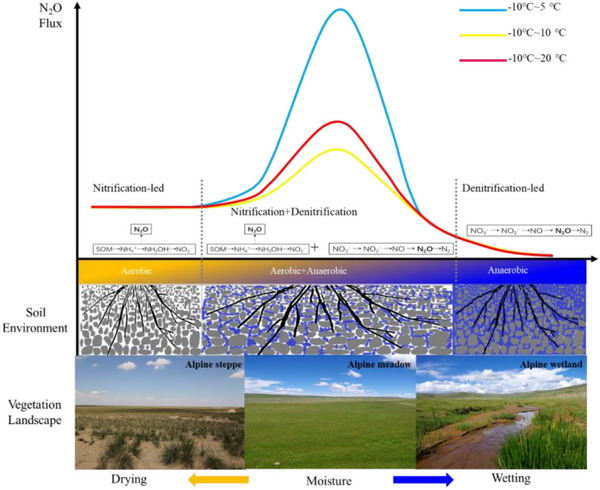Large quantities of organic matter are stored in frozen soils (permafrost) within the Qinghai–Tibetan Plateau (QTP). The most of QTP regions in particular have experienced significant warming and wetting over the past 50 years, and this warming trend is projected to intensify in the future. Such climate change will likely alter the soil freeze–thaw pattern in permafrost active layer and toward significant greenhouse gas nitrous oxide (N2O) release. However, the interaction effect of warming and altered soil moisture on N2O emission during freezing and thawing is unclear. Here, we used simulation experiments to test how changes in N2O flux relate to different thawing temperatures (T5–5°C, T10–10°C, and T20–20°C) and soil volumetric water contents (VWCs, W15–15%, W30–30%, and W45–45%) under 165 F–T cycles in topsoil (0–20 cm) of an alpine meadow with discontinuous permafrost in the QTP. First, in contrast to the prevailing view, soil moisture but not thawing temperature dominated the large N2O pulses during F–T events. The maximum emissions, 1,123.16–5,849.54 μg m–2 h–1, appeared in the range of soil VWC from 17% to 38%. However, the mean N2O fluxes had no significant difference between different thawing temperatures when soil was dry or waterlogged. Second, in medium soil moisture, low thawing temperature is more able to promote soil N2O emission than high temperature. For example, the peak value (5,849.54 μgm–2h–1) and cumulative emissions (366.6 mgm–2) of W30T5 treatment were five times and two to four times higher than W30T10 and W30T20, respectively. Third, during long-term freeze–thaw cycles, the patterns of cumulative N2O emissions were related to soil moisture. treatments; on the contrary, the cumulative emissions of W45 treatments slowly increased until more than 80 cycles. Finally, long-term freeze–thaw cycles could improve nitrogen availability, prolong N2O release time, and increase N2O cumulative emission in permafrost active layer. Particularly, the high emission was concentrated in the first 27 and 48 cycles in W15 and W30, respectively. Overall, our study highlighted that large emissions of N2O in F–T events tend to occur in medium moisture soil at lower thawing temperature; the increased number of F–T cycles may enhance N2O emission and nitrogen mineralization in permafrost active layer.

Figure Model of N2O flux response to soil moisture and temperature during short-term freeze–thaw cycles. The horizontal axis represents soil moisture, increasing from left to right. The diagram below the abscissa shows the soil environment under different soil water contents, in which the black lines represent plant roots, the gray irregular geometric shapes represent soil aggregates, the white gaps represent interstices of soil, and the blue parts represent soil free water. The photo of vegetation landscape from left to right is alpine steppe, alpine meadow, and alpine wetland. All the photos were taken by the first author in the Qinghai–Tibetan Plateau.
This result was published in Frontiers in Ecology and Evolution with the title of “Soil Moisture but Not Warming Dominates Nitrous Oxide Emissions During Freeze–Thaw Cycles in a Qinghai–Tibetan Plateau Alpine Meadow With Discontinuous Permafrost”.
The link below will guide you to the reading:
https://www.frontiersin.org/articles/10.3389/fevo.2021.676027/full
